|
|
|
|
|
|
|
|
|
|
|
|
|
|
|
|
|
|
|
|
|
|
Multscher, Hans
|
|
German Northern Renaissance Sculptor, ca.1400-1467
German sculptor. Multscher mentions his birthplace on the inscribed band, originally a predella, of the Karg altarpiece in Ulm Cathedral (1433) and on two wings of the so-called 'Wurzach Altar' (1437) at Reichenhofen in the Allgeu. The town archives of Leutkirch, written between 1405 and 1437, record that Multscher belonged to the 'Freien Leute auf Leutkircher Heide', a commune of free peasants who had been able to preserve their independence because they were the direct descendants of Kenigsfreie, who had always been free. Under a charter of Emperor Ludwig in 1337 |
|
|
|
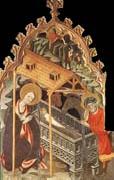 |
MUR, Ramon de
|
|
Catalan painter
active in first half of 14th century in Tarragona |
|
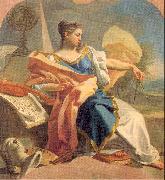 |
Mura, Francesco de
|
|
Italian, 1696-1782
Italian painter. He was educated initially in the workshop of Domenico Viola at Naples, but in 1708 he entered the school of Francesco Solimena, whose favourite pupil and most trusted collaborator he became. At first he followed closely Solimena's monumental Baroque manner, as in the frescoes (1715) in S Nicola alla Carit? in Naples, but later developed a more controlled and refined style of rhythmical lines, light and airy colours and delicate psychological overtones. He employed this new style in his ten canvases of the Virtues and his vast Adoration of the Magi (all 1728; Naples, S Maria Donnaromita) and, above all, in his frescoes of the Adoration of the Magi in the apsidal dome of the church of the Nunziatella, Naples (1732; in situ). De Mura was also active as a portrait painter; his Portrait of the Artist's Wife |
|
|
|
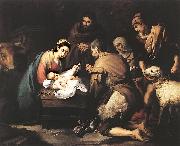 |
MURILLO, Bartolome Esteban
|
|
Spanish Baroque Era Painter, ca.1617-1682
Spanish religious and portrait painter. He was born in Seville, where most of his life was spent. There, c.1645, he painted a series of 11 pictures of the history of the Franciscan order for a monastery. These brought him immediate fame, and for the remainder of his life he was the favorite painter of the wealthy and pious Andalusian capital. His early works show the influence of Zurbarn in the dramatic use of light and shadow. Murillo adapted several compositions from northern and Italian prints. Notable works of his early years include St. Leander, St. Isidore, Vision of St. Anthony (all: cathedral, Seville), Birth of the Virgin (Louvre), and his series for the Church of Santa Maria la Blanca. In 1660 he was instrumental in founding the Seville Academy, of which he shared the presidency with the younger Francisco de Herrera. From 1670 to 1682, Murillo painted many of his major religious works, including those for the Charity Hospital and for the Capuchin convent (Seville Mus.). These religious works, particularly the Madonnas, are noted for their sweetness of mood. In 1682, while working on the Marriage of St. Catherine for the Capuchin church of Cediz, Murillo fell from a scaffold and died as a result of his injuries. Murillo's greatest works include his fine portraits, Don Andres de Andrade y la Col (Metropolitan Mus.) and Knight of the Collar (Prado) and his naturalistic genre paintings, such as Girl and Her Duenna (National Gall., Washington, D.C.) and Peasant Boy (National Gall., London). |
|
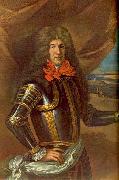 |
Musee national de la Marine
|
|
(National Navy Museum) is a maritime museum located in the Palais de Chaillot, Trocadero, in the XVIe arrondissement of Paris. It has annexes at Brest, Port-Louis, Rochefort (Musee National de la Marine de Rochefort), Toulon and Saint-Tropez. The permanent collection originates in a collection that dates back to Louis XV of France.
In 1748, Henri-Louis Duhamel du Monceau offered a collection of models of ships and naval installations to Louis XV of France, with the request that the items be displayed at the Louvre and made available to students of the Naval engineers school, which Duhamel headed. The collection was put on display in 1752, in a room of the first floor, next to the Academy of Sciences; the room was called "Salle de Marine" (Navy room), and was used for teaching.
With the French Revolution, the Salle de Marine closed in 1793. The collection was added to models owned by the King personally, to others owned by the Ministry of Navy, and yet others owned by emigres or executees (notably Philippe Égalite). A short-lived museum was opened between 1801 and 1803 at the Ministry of Navy, then located at Place de la Concorde.
|
|
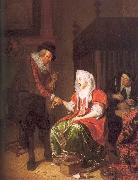 |
Musscher, Michiel van
|
|
Dutch, 1645-1705
Dutch painter and printmaker. According to Houbraken, van Musscher received his eclectic artistic training in Amsterdam, studying first with the history painter Martinus Zaagmolen (c. 1620-69) in 1660, then with Abraham van den Tempel in 1661, followed by lessons with Gabriel Metsu in 1665. He completed his studies in 1667 in the studio of Adriaen van Ostade. The following year van Musscher returned briefly to Rotterdam before settling permanently in Amsterdam. |
|
 |
Myles Birket Foster,RWS
|
|
1825-1899
English painter, illustrator and collector. After a short and unsatisfactory period working in the family brewing business, he was able to convince his Quaker parents to allow him to pursue a career in art. He was apprenticed to a wood-engraver, Ebenezer Landells (1808-60), who recognized Foster's talent for drawing and set him to work designing blocks for engraving. Foster also provided designs for Punch and the Illustrated London News. In 1846 he set up on his own as an illustrator. The rustic vignettes of the seasons that he contributed to the Illustrated London News and its counterpart, the Illustrated London Almanack, established him as a charming interpreter of the English countryside and rural life and led to his employment illustrating similar themes in other publications. During the 1850s his designs were much in demand; he was called upon to illustrate volumes of the poetry of Longfellow, Sir Walter Scott and John Milton. |
|
|
|
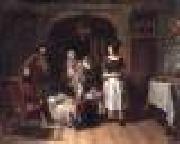 |
NAIVEU, Matthijs
|
|
Dutch painter (1647-1726)
Dutch painter. He was the son of a wine merchant from Rotterdam and began his training with Abraham Toorenvliet (c. 1620-92), a glass painter and drawing master in Leiden. From 1667 to 1669 Naiveu was apprenticed to the Leiden 'Fine' painter Gerrit Dou, who received 100 guilders a year (an exceptionally high sum) for instructing Naiveu. In 1671 Naiveu entered the Leiden Guild of St Luke, of which he became the head in 1677 and again in 1678, the year in which he moved to Amsterdam, where he was later appointed hop inspector. This work did not prevent him producing a considerable number of paintings; the earliest known work by Naiveu is dated 1668, the latest 1721. |
|
|
|
 |
Nesterov, Mikhail
|
|
Russian, 1862-1942
Russian painter. From 1877 to 1881 and again from 1884 to 1886 he studied at the Moscow School of Painting, Sculpture and Architecture under the Realist painters Vasily Perov and Illarion Pryanishnikov. Between 1881 and 1884 he worked under Pavel Chistyakov (1832-1919) at the Academy of Arts, St Petersburg. At the estate of Savva Mamontov at Abramtsevo he met the most influential painters of the period, then at the epicentre of the development of Russian Art Nouveau. Nesterov sought to combine this style with a deep Orthodox belief; however, in his desire to revive religious art he was influenced more by French Symbolism, particularly by Bastien-Lepage, than by old Russian icon painting. All of Nesterov's canvases are marked by a lyrical synthesis between the figures and their landscape surroundings, as in Hermit (1888-9; Moscow, Tret'yakov Gal.), which shows the stooped figure of an old man against a northern landscape of stunted trees and still water. The large oil painting Vision of Young Bartholomew (1889-90; Moscow, Tret'yakov Gal.) depicts the legend of the childhood of the Russian saint Sergey of Radonezh. A monk appears to the young Bartholomew (the future St Sergius) and prophesies a glorious future for him. |
|
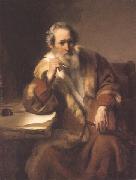 |
Nicolaes maes
|
|
Dutch Baroque Era Painter, 1634-1693
Dutch painter. The son of the prosperous Dordrecht merchant Gerrit Maes and his wife Ida Herman Claesdr., Nicolaes Maes learnt to draw from a 'mediocre master' (Houbraken) in his native town before he studied painting with Rembrandt in Amsterdam. His training in Rembrandt's studio must have taken place between 1648/50 and 1653. By December 1653 Maes had settled in Dordrecht and made plans to marry, while a signed and dated picture of 1653 confirms that the 19-year-old artist had completed his training and embarked on an independent career. |
|
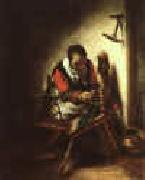 |
Nicolas Maes
|
|
1634-1693
Dutch Nicolas Maes Galleries
Nicolaes Maes, also known as Nicolaes Maas (January 1634, Dordrecht - buried November 24, 1693, Amsterdam) was a Dutch Baroque painter of genre and portraits.
Maes was the son of Gerrit Maes, a prosperous merchant, and Ida Herman Claesdr. In about 1648 he went to Amsterdam, where he entered Rembrandt's studio. Before his return to Dordrecht in 1653 Maes painted a few Rembrandtesque genre pictures, with life-size figures and in a deep glowing scheme of colour, like the Reverie at the Rijksmuseum in Amsterdam, the Card Players at the National Gallery, and the Children with a Goat Carriage. So closely did his early style resemble that of Rembrandt, that the last-named picture, and other canvases in the Leipzig and Budapest galleries and in the collection of Lord Radnor, were or are still ascribed to Rembrandt.
In his best period, from 1655 to 1665, Maes devoted himself to domestic genre on a smaller scale, retaining to a great extent the magic of colour he had learnt from Rembrandt. Only on rare occasions did he treat scriptural subjects, as in Hagar's Departure, which has been ascribed to Rembrandt. His favorite subjects were women spinning, or reading the Bible, or preparing a meal.
While he continued to reside in Dordrecht until 1673, when he settled in Amsterdam, he visited or even lived in Antwerp between 1665 and 1667. His Antwerp period coincides with a complete change in style and subject. He devoted himself almost exclusively to portraiture, and abandoned the intimacy and glowing color harmonies of his earlier work for a careless elegance which suggests the influence of Van Dyck. So great indeed was the change, that it gave rise to the theory of the existence of another Maes, of Brussels.
Maes is well represented at the London National Gallery by five paintings: The Cradle, The Dutch Housewife, The Idle Servant, The Card Players, and a man's portrait. At Amsterdam, besides the splendid examples to be found at the Rijksmuseum, is the Inquisitive Servant of the Six collection. At Buckingham Palace is The Listening Girl (repetitions exist), and at Apsley House Selling Milk and The Listener. Other notable examples are at the Berlin, Brussels, St Petersburg, the Hague, Frankfort, Hanover and Munich galleries. |
|
 |
Nicolas Mignard
|
|
(1606-1668) was a French 17th Century painter. He spent most of his active life in Avignon and was the older brother of Pierre Mignard.
Nicolas Mignard was born in Troyes in 1606. There, he studied painting with a local master. After traveling to Fontainebleau, Mignard came to Avignon in 1632. He then traveled to Rome with Cardinal Archbishop of Lyon. Mignard came back to Avignon in 1636, after having executed multiple series of etching in Rome. There, he mostly painted for religious institutions. Mignard spent the end of his life in Paris, where he became a successful portrait painter. Mignard left Paris after a visit of King Louis XIV and his Court in Avignon. King Louis XIV decided to bring Mignard to Paris. Mignard eventually joined the Academie Royale.
Mignardes spending most of his life in Avignon made his career somewhat overshadowed by his little brother Pierre, who was installed in Paris. After his death, paintings by Nicolas Mignard mostly stayed in Avignon or in small cities around Avignon. During the French Revolution, as these paintings were taken over, most of them were attributed to Pierre Mignard.
His art is now rediscovered. His style is typical of the Italianate classicizing aesthetic that dominated seventeenth-century France, and obviously was very much influenced by French classical Baroque painter Poussin.
Nicolas Mignard died in 1668 in Paris.
|
|
 |
Nicolas-Andre Monsiau
|
|
(1754 -- 31 May 1837) was a French history painter and a refined draughtsman who turned to book illustration to supplement his income when the French Revolution disrupted patronage. His cool Poussiniste drawing style and coloring marked his conservative art in the age of Neoclassicism.
His training at the school of the Academie royale de peinture et de sculpture, Paris, was under the direction of Jean-François-Pierre Peyron. An early patron, the marquis de Corberon, paid for a sojourn at Rome, where he studied at the French Academy in Rome from 1776. On his return to Paris, he was unable to exhibit in the annual Paris salons, which were closed to all but those who had been received by the Academie or were members, under the Ancien Regime. Instead he found an outlet in the smaller Salon de la correspondance, where in 1782 he showed a tenebrist Piquant effect of the light of a lamp.
Two years later he was received at the Academie with a historical subject, Alexander taming Bucephalus and was made a member 3 October 1787, his second attempt, on the strength of The Death of Agis. The influence of Jacques-Louis David, an acquaintance from Monsiau's days in Rome, is most vividly represented by Monsiau's Ulysses, after returning to his palace and slaying Penelope's suitors, orders the women to remove the corpses (1791 Salon), where the action is played out in a shallow frieze-like space defined by a colonnade parallel to the picture plane.
In his best-known painting, Zeuxis choosing among the most beautiful girls of Crotona, shown at the Salon of 1791,Monsiau illustrates an anecdote of the painter Zeuxis, recorded in Pliny's Natural History, that exemplifies an essential aspect of the Classical approach to artistic creation, in the artist's refining an ideal Art by selecting from among the lesser beauties of Nature.
Monsiau's great public commission was a commemoration of the occasion on 26 January 1802, at which Napoleon delivered an authoritarian constitution to the Cisalpine Republic at a convocation of notables (the consulta) at Lyon. François Gerard had turned down the commission, preferring to continue his series of individual portraits of the Bonapartes. Monsiau received the commission in 1806; the finished painting was exhibited at the Salon of 1808 and was installed at the Tuileries the following year.
Monsiau was among the first history painters to depict scenes from modern history that were not commemorations of battles. He showed Moliere reading Tartuffe at the house of Ninon de Lenclos at the Salon of 1802. It was engraved by Jean-Lous Anselin. His painting of Louis XVI giving instructions to the sea captain-explorer La Perouse before his attempted circumnavigation was exhibited at the Salon of 1817 and was purchased for the recently restored Louis XVIII.
His portrayal of a sensational episode in which an escaped lion from the Grand Ducal menagerie in Florence had dropped a child it had picked up, without harming it, was exhibited at the Salon of 1801 and is conserved in the Louvre.
Among his pupils was the portrait draughtsman Louis Letronne (1790--1842), whose pencil portrait of Ludwig van Beethoven is iconic. |
|
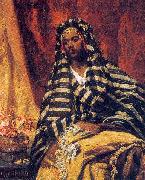 |
Noble, Thomas Satterwhite
|
|
American, 1835-1907
was born in Lexington, Kentucky. He grew up on a plantation where hemp and cotton were grown. Noble saw the effects of slavery firsthand and portrayed many scenes of the Old South in his works. He attended Transylvania University in Lexington and studied art with Oliver Frazier and George P. A. Healey and moved to New York, New York in 1853 at age eighteen. He first studied painting with Samuel Woodson Price in Louisville, Kentucky in 1852, then with Thomas Couture in Paris, 1856-1859 and returned to the United States in 1859. He served in the Confederate army from 1862-1865 during the American Civil War, despite his avowed hatred for slavery. After the war, he had a studio in New York City 1866-1869. In 1869, Noble was invited to become the first head of the McMicken School of Design in Cincinnati, Ohio, a post he would hold until 1904. During his tenure at the McMicken School of Design, Noble moved briefly to Munich, Germany where he studied from 1881-1883. He retired in 1904 and died in New York City, April 27, 1907. He is buried in Spring Grove Cemetery in Cincinnati. Noble's works are largely historical presentations. Modern critics have viewed them as overly romanticized, while others believe that he painted realistic scenes from actual events. One of his most famous paintings is The Modern Medea (1867) which portrays a tragic event from 1856 in which Margaret Garner, a fugitive slave mother, has murdered one of her children, rather than see it returned to slavery. |
|
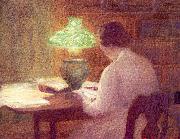 |
Ochtman, Mina Fonda
|
|
American, 1862-1924
was the wife of the American painter Leonard Ochtman and a notable American Impressionist in her own right. She was a part of the Cos Cob Art Colony and lived in Greenwich, Connecticut. Their daughter, Dorothy Ochtman Del Mar, was also a painter of note. |
|
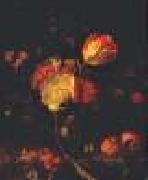 |
OOSTERWIJK, Maria van
|
|
Dutch woman painter (b. 1630, Nootdorp, d. 1693, Uitdam)
was a Dutch Baroque painter, specializing in richly detailed still lifes. She was a student of Jan Davidsz de Heem. Van Oosterwijk worked in Delft and later in Amsterdam (1675-1689), where she lived opposite the workshop of Willem van Aelst. She was popular with European royalty, including Emperor Leopold, Louis XIV of France and William III of England. Despite this, as a woman, she was not allowed to join the painters' guild. Her work is in many prominent collections, including the Fitzwilliam Museum (Cambridge), the Kunsthistorisches Museum (Vienna), the Palatine Gallery in Palazzo Pitti (Florence), the Royal Collection |
|
|
|
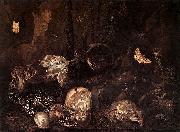 |
Otto Marseus van Schrieck
|
|
(ca. 1619, Nijmegen - buried June 22, 1678, Amsterdam) was a painter in the Dutch Golden Age.
Marseus van Schrieck spent the years 1648-1657 in Rome and Florence with the painters Matthias Withoos and Willem van Aelst, after which he settled in Amsterdam. He is best known for his paintings of forest flora and fauna. In Arnold Houbraken's biography of him, he mentions that he joined the Bentvueghels in Rome and was called the snuffelaer, or "sniffer", because he was always sniffing strange lizards and snakes. He quotes his wife, who apparently survived him by two husbands and was still alive when he wrote the book. He wrote that she said that Otto kept snakes and lizards in a shed at the back of his house, and also on a piece of land outside the city that was walled in for this purpose.
|
|
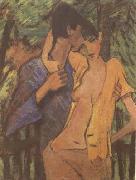 |
Otto Mueller
|
|
German Painter, 1874-1930
Otto Mueller was born on October 16, 1874, in Liebau, German Silesia. His mother had been adopted as a young girl, giving rise to the story that he was the son of a gypsy - a story he never denied. He was a cousin to the famous German writers and dramatists Gerhart and Carl Hauptmann (the latter's novel "Einhart der Lächler" is an imaginary portrait of the painter). After four years of apprenticeship with a lithographer, Mueller entered the Academy of Fine Arts in Dresden in 1894. He was dissatisfied with the conservative instructions and left after two years. The next several years he lived close to his influential cousins, and for a short while he went to Munich to study with the famous painter Franz von Stuck. Information about his life and work until 1908 - when he settled in Berlin - is sketchy, especially since the artist destroyed many of his earlier works. In Berlin Mueller met the expressionist sculptor Wilhelm Lehmbruck, whose concept of the human form had a decisive influence on his own perception. When in 1910 his entries to the exhibition of the Berlin Secession were rejected he joined the members of the artist group "Die Brecke" (The Bridge) and exhibited with the New Secession and thus met Ernst Ludwig Kirchner, Ernst Heckel, and Karl Schmidt-Rottluff. He became their lifelong friend, and, while only slightly influenced by their woodcut techniques, he contributed in return his experience in lithography and especially his techniques of distemper painting (colors bound by glue or size). This technique permits the quick coverage of large areas of the very rough canvas (burlap) which he preferred and adds a subdued luminosity. Since overpainting in distemper is not possible, the artist has to have a clear conception of his work before he begins. The technical devices strengthened the Brecke painters' desire to "flatten" the image on the canvas - following the examples of Paul Gauguin and even Edvard Munch and rejecting the academic preference for an emphasis on three-dimensionality of the subject. In his graphic works Mueller experimented with mixtures of woodcut and lithography, the rubbing of the printer's ink, frequently adding color in the form of watercolor or colored chalk, until he had the technical means of the Breslau Academy available to make true color lithographs. His "Gypsy-Portfolio" (nine color lithographs in a portfolio of 1927), which used as many as five stones, is one of his great achievements as a graphic artist. From 1916 to 1918 he served as a soldier in World War I, an experience which left no impact on his work. Shortly after his return he was appointed professor at the Breslau Academy of Art, where he taught until his death. Mueller's work shows only three motifs: landscapes, gypsies, and primarily nudes in landscapes. The last motif dominated his work. The earthen color of his mostly young, subtle but angular nude girls forms with the subdued and delicate greens of the landscape backgrounds a vision of a lost past. There is a frequently melancholic nostalgia in his works, presenting a harmony between nature and the human form which is not only opposite to the academic approach but also to that of the other Expressionists. |
|
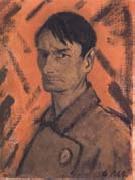 |
Otto Muller
|
|
1874-1930
was a German painter and printmaker of the Die Br??cke expressionist movement. Otto Mueller was born in Liebau (now Lubawka, Kamienna G??ra County), Kreis Landeshut, German Silesia. Between 1890-1892 he was trained in lithography in Görlitz and Breslau. From 1894 to 1896 he studied at the Academy of Fine Arts in Dresden and continued his study in Munich 1898. He left Munich's academy after Franz von Stuck classified him as untalented. His early works are influenced by impressionism, Jugendstil and symbolism. When he settled to Berlin in 1908, he turned more and more to the expressionism. During this time there were meetings with Wilhelm Lehmbruck, Rainer Maria Rilke and Erich Heckel. In 1910, he joined 'Die Br??cke', a Dresden-based group of Expressionist artists. He was member of the group until it disbanded in 1913 due to artistic differences. At the same time Mueller also had contact with the artists group of the 'Blaue Reiter'. During the World War I he fought as a German soldier in France and Russia. After the war he became professor at the academy of arts (Akademie der Bildenden Kunste) in Breslau where he taught until his death on September 24, 1930. Johnny Friedlaender and Isidor Ascheim were among his pupils there. Altogether his printmaking amounted to 172 prints, in woodcut, etching and lithography. In 1937 the Nazis seized 357 of his works from German museums, since the pictures were considered as degenerate art. Mueller was one of the most lyrical of German expressionist painters. The central topic in Mueller's works is the unity of humans and nature, whereas his paintings are focused on a harmonious simplification of form, colour and contours. |
|
|
|
|
|
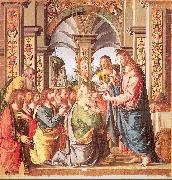 |
Palmezzano, Marco
|
|
Italian, Approx. 1459-1539
.Italian painter. His earliest work was probably on the fresco decoration (c. 1480-84) of the vault of the sacristy of the treasury in the Santa Casa, Loreto, designed by Melozzo da Forl?. He then probably went to Rome, where he may have painted the fresco in the apse of Santa Croce in Gerusalemme (Longhi). In 1493 Palmezzano is documented working with Melozzo on the fresco decoration in the Feo Chapel, |
|
|
|
|
|
|
|
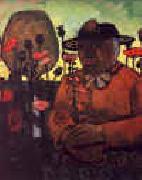 |
Paula Modersohn-Becker
|
|
German
1876-1907
Paula Becker was born and grew up in Dresden-Friedrichstadt. She was the third child of seven children in her family. Her father who was the son of a Russian university professor, was employed with the German railway. He and Modersohn-Becker's mother, who was from an aristocratic family, provided the children a cultured and intellectual environment in the house hold.
Modersohn-Becker's parental home 1888-1899In 1888 her parents moved from Dresden to Bremen. While visiting an aunt in London, England, she received her first instruction in drawing. Apart from her teacher's training in Bremen in 1893-1895, Paula took private instruction in painting. In 1896 she participated in a course for painting and drawing sponsored by the "Verein der Berliner K??nstlerinnen" (Union of Berlin Female Artists) which offered art studies to women.
Paula Modersohn-Becker. Clara Rilke WesthoffAt the age of 22, she encountered the artistic community of Worpswede. In this "village", artists such as Fritz Mackensen (1866-1953) and Heinrich Vogeler (1872-1942) had retreated to protest against the domination of the art academy and life in the big city. At Worpswede, Paula Modersohn-Becker took painting lessons from Mackensen. The main subjects were the life of the farmers and the northern German landscape. At this time she began close friendships with the sculptor Clara Westhoff (1875-1954) and the poet Rainer Maria Rilke (1875-1926). She also fell in love during this period, and in 1901 she married a fellow Worpswede painter, Otto Modersohn. In marrying Otto, she also became a stepmother to Otto's daughter, Elsbeth Modersohn, the child from his first marriage to Helene Modersohn, then deceased.
Paula Modersohn-Becker. Rainer Maria Rilke, 1906Between 1900 and 1907, Paula made several extended trips to Paris for artistic purposes, sometimes living separately from her husband, Otto. During one of her residencies in Paris, she took courses at the Ecole des Beaux-Arts. She visited contemporary exhibitions often, and was particularly intrigued with the work of Paul C??zanne. Other post impressionists were especially influential, including Vincent Van Gogh and Paul Gauguin. Fauve influences may also appear in such works as Poorhouse Woman with a Glass Bottle. The influence by the work of French painter, Jean-Francois Millet, who was widely admired among the artists in the Worpswede group, may be seen in such pieces as her 1900 Peat Cutters.
Reclining Mother and ChildIn her last trip to Paris in 1906, she produced a body of paintings from which she felt very great excitement and satisfaction. During this period of painting, she produced her initial nude self-portraits (something surely unprecedented by a female painter) and portraits of friends such as Rainer Maria Rilke and Werner Sombart. Some critics consider this period of her art production to be the strongest and most compelling.
Paula with Mathilde, November 1907 (days before Paula's death)In 1907, Paula Modersohn-Becker returned to her husband in Worpswede. Their relationship, which had been particularly strained in 1906, had taken a turn towards improvement. Paula's long-lived wish to conceive and bear a child was fulfilled. Her daughter Mathilde (Tillie) Modersohn was born on November 2, 1907. Paula and Otto were joyous. Sadly, the joy became soon overshadowed by tragedy, as Paula Modersohn-Becker died suddenly in Worpswede on November 20th from an embolism.
In 1908, Rainer Maria Rilke wrote the renowned poem, "Requiem for a Friend", in Paula's memory. The poem was born of the imprint that Paula's life, death and friendship left upon Rilke. |
|
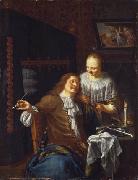 |
Paulus Moreelse
|
|
(1571, Utrecht - 6 March 1638, Utrecht) was a Dutch painter, mainly of portraits.
Moreelse was a pupil of the Delft portrait painter Michiel Jansz. van Mierevelt, who had himself been a pupil of Anthonie van Blocklandt. He took a study-trip to Italy, where he received many portrait commissions. Back in Utrecht, in 1596 he became a member of the zadelaarsgilde, which was the traditional name in Utrecht for the Guild of Saint Luke. In 1611, along with Abraham Bloemaert, he was one of the founders of a new painters' guild, called "St. Lucas-gilde", and became its first deken.
Moreelse was a well known portrait painter who received commissions from right across the Dutch Republic. His earliest work dates to 1606. Other than portraits, he also painted a few history paintings in the Mannerist style and in the 1620s produced pastoral scenes of herders and shepherds. He belonged to the same generation as Abraham Bloemaert and Joachim Wtewael, and like Wtewael he played an important role in the public life of their city. His version of Diana and Callisto was engraved by Jan Saenredam. In 1618, when the anti-remonstrants came to power in Utrecht, he was raadslid.
|
|
|
|
|
|
 |
Peter Monamy
|
|
was an English marine painter who lived between 1681 and 1749.
Peter Monamy was baptised at the church of St Botolph's-without-Aldgate, London, England, on 12 January 1681 (new style). He was the last known surviving child of Peter, or Pierre, Monamy, born 1650 in Guernsey, and his English wife, Dorothy Gilbert; and the grandson of Andre Monamy, 1612-1680, who had been a strongly committed Commonwealth Parliamentarian in Guernsey during the 1650s. Dorothy Gilbert was the daughter of James Gilbert, who was Master of the Worshipful Company of Gunmakers in 1670 and 1672. The Monamy family had been prominent merchants and residents of Guernsey since at least the 1560s, and in the Channel Islands since the 1530s. The painter's father, Pierre, had a brother named Andre, or Andrew, who was active in London as a merchant trader in salt and wool, during the late 17th and early 18th centuries. In December, 1696, Andrew Monamy, together with his cousin, Daniel Le Febvre, is described as "guardian" of the children of Peter (i.e. Pierre) Monamy, deceased. The elder Peter Monamy appears to have died in about 1685.
On 3 September 1696, Peter Monamy, aged 15, was bound as an apprentice for seven years by indenture to William Clark, a former (1687) Master of the Worshipful Company of Painter-Stainers, one of London's ancient guilds of craftsmen. Clark is recorded in several capacities in the London of the late 17th century, as a constable and juryman, with premises in Thames Street, and on London Bridge, and practised as what would today be called an interior decorator, with a thriving business. House decoration comprised a wide range of activities, including the provision of paintings as overdoors, and on panelling, house murals on canvas as well as decorative sign-boards for trade establishments. William Clark died before January, 1704, when his will was proved. |
|
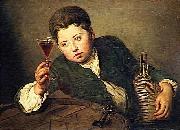 |
Philipe Mercier
|
|
Philippe Mercier (also known as Philip Mercier) (Berlin, 1689 - London, 18 July 1760) was a French painter and etcher, who lived principally and was active in England. He was born in Berlin of French extraction, the son of a Huguenot tapestry-worker. He studied painting at the Akademie der Wissenschaften of Berlin[1] and later under Antoine Pesne, who had arrived in Berlin in 1710. Later, he traveled in Italy and France before arriving in Londone"recommended by the Court at Hannover"eprobably in 1716. He married in London in 1719 and lived in Leicester Fields.
He was appointed principal painter and librarian to the Prince and Princess of Wales at their independent establishment in Leicester Fields, and while he was in favor he painted various portraits of the Royalties, and no doubt many of the nobility and gentry. Of the Royal portraits, those of the Prince of Wales and of his three sisters, painted in 1728, were all engraved in mezzotint by Jean Pierre Simon, and that of the three elder children of the Prince of Wales by the John Faber Junior in 1744. This last was a typical piece of Mercier's composition, the children being made the subject of a spirited, if somewhat childish, allegory in their game of play. Prince George is represented with a firelock on his shoulder, teaching a dog his drill, while his little brother and sister are equally occupied in a scene that is aptly used to point a patriotic moral embodied in some verses subjoined to the plate
|
|
|
|
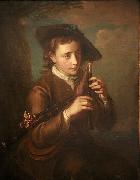 |
Philippe Mercier
|
|
(also known as Philip Mercier) (Berlin, 1689 - London, 18 July 1760) was a French painter and etcher, who lived principally and was active in England. He was born in Berlin of French extraction, the son of a Huguenot tapestry-worker. He studied painting at the Akademie der Wissenschaften of Berlin[1] and later under Antoine Pesne, who had arrived in Berlin in 1710. Later, he traveled in Italy and France before arriving in Londone"recommended by the Court at Hannover"eprobably in 1716. He married in London in 1719 and lived in Leicester Fields.
He was appointed principal painter and librarian to the Prince and Princess of Wales at their independent establishment in Leicester Fields, and while he was in favor he painted various portraits of the Royalties, and no doubt many of the nobility and gentry. Of the Royal portraits, those of the Prince of Wales and of his three sisters, painted in 1728, were all engraved in mezzotint by Jean Pierre Simon, and that of the three elder children of the Prince of Wales by the John Faber Junior in 1744. This last was a typical piece of Mercier's composition, the children being made the subject of a spirited, if somewhat childish, allegory in their game of play. Prince George is represented with a firelock on his shoulder, teaching a dog his drill, while his little brother and sister are equally occupied in a scene that is aptly used to point a patriotic
|
|
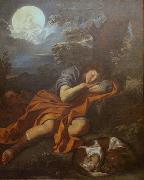 |
Pier Francesco Mola
|
|
(9 February 1612 - 13 May 1666) was an Italian painter of the High Baroque, mainly active around Rome.
Mola was born at Coldrerio (now in Ticino, Switzerland). At the age of four, he moved to Rome with his father Giovanni Battista, a painter. With the exception of the years 1633 - 40 and 1641 - 47, during which he resided in Venice and Bologna, respectively, he lived for the rest of his life in Rome.
His early training was with the late mannerist painter Cavalier D'Arpino, and he worked under the classicizing Francesco Albani.
His masterpiece is the fresco in the gallery of Alexander VII in the Quirinal Palace Gallery, entitled Joseph making himself known to his Brethren (1657). He made six versions of The Flight into Egypt, the earileist and best of which is the first one, The Rest on the Flight into Egypt.
He was elected Principe of the Accademia di San Luca, the Roman artists' professional association, in 1662, but his last years were neither profitable nor prolific. One of his pupils was Antonio Gherardi.
With his looser style and handling, more naturalistic palette, and interest in exploring landscape elements, Mola rebelled against the prevailing, highly-theoretical classicism of such leading 17th-century Roman painters as Andrea Sacchi.
|
|
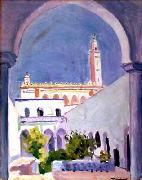 |
Pierre Albert Marquet Prints
|
|
French 1875- 1947
Marquet was born in Bordeaux. In 1890 he moved to Paris to attend the Decorative Arts School, where he met Henri Matisse. They were roommates for a time, and they influenced each other's work. Marquet began studies in 1892 at the École des Beaux-Arts under Gustave Moreau, a symbolist artist who was a follower of the Romantic tradition of Eug??ne Delacroix.
In these years, Marquet exhibited paintings at the Salon des Ind??pendants. Although he did not sell many paintings, the artistic community of Paris became aware of his work. His early compositions were characterised by a clear and painterly Fauvist approach, in which he had a fine control of the drawing and responded to light, not only by intensifying the strongest tones, but also by seeing the weaker ones in coloristic terms.
In 1905 he exhibited at the Salon d'Automne where his paintings were put together with those of Henri Matisse, Maurice de Vlaminck, Andr?? Derain, Othon Friesz, Georges Rouault, Raoul Dufy, Henri Manguin, Georges Braque, Louis Valtat and Jean Puy.
Dismayed by the intense coloration in these paintings, critics reacted by naming the artists the "Fauves", i.e. savage beasts. Although Marquet painted with the fauves for years, he used less bright and violent colours than the others, and emphasized less intense tones made by mixing complementaries, thus always as colors and never as grays.
At the end of 1907 he stayed in Paris and dedicated himself, together with Henri Matisse, to a series of city views. The fundamental difference between the two is that while Matisse used strong colours, Marquet favored grayed yellows, greyed violets or blues. Black was usually used as a violent contrast to light colors for such forms as bare tree trunks or calligraphically drawn people contrasted with very light, often yellow or orange streets and sidewalks. Another difference is that Marquet used an approximation of traditional perspective, although his colors and compositions constantly referred to the rectangle and cut its plane with their calligraphy.
From 1907 to his death, Marquet alternated between working in his studio in Paris and many parts of the European coast and in North Africa. He was most involved with Algeria and Algiers and with Tunisia. In his voyages he painted the sea and ships, but also the lights and animated life of the city, especially cities on the waterfront, like Algiers.
Among European cities Marquet remained impressed particularly with Naples and Venice where he painted the sea and boats, accenting the light over water. He adopted a technique nothing like the Impressionists', painting water as a large area of simple tone which held the plane of the water surface without illusionistic perspective, from which the ships arise into a different plane. His views of the lagoon in Venice do this very economically. The water stays at a right angle to the picture plane and the large ships float with ease, with their reflections exactly the correct tone to project the required space. His color is much like Matisse of the 1920s, here. His contrasts of vivid colors describe the waves of the sea with simple drawing which accompany the exactly observed color tones, giving a scene of placid movement. The human figures are much simplified, calligraphically drawn in a way related to Japanese Shijo style work. Matisse is said to have called him "our Hokusai".
During his voyages to Germany and Sweden he painted the subjects he usually preferred: river and sea views, ports and ships, but also cityscapes. Over the course of his career he often returned to the same subjects, even years later, recording subtle differences in the light. He painted a few portraits, and between 1910 and 1914 he painted a series of nudes in whorehouses, and prepared the illustration of a work on lesbian lovers. But he is best known for his many landscapes.
Unlike Matisse, there are no obvious periods of change in his work. To the end he was one of Matisse's closest friends, and they discussed each other's work with the greatest openness. His death was unexpected and sudden, from a gall bladder attack and subsequently discovered cancer, for which at that time there was no therapy. Marquet died in Paris, on 14 June 1947. |
|
|
|
|

